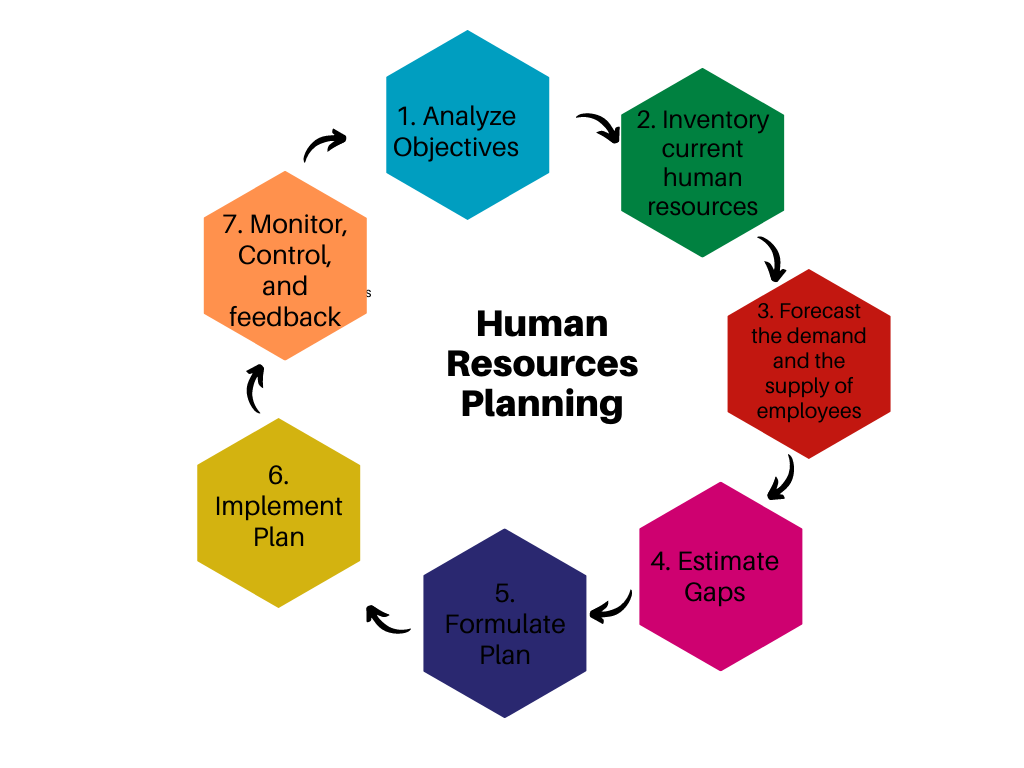Human resources are one of the most important assets for any business organization. In order to take maximum benefit of the available human resources, an organization must have a Human Resources Planning process (HRP). Human Resources planning is a continuous process that should carry out by the Human resources department of an organization to ensure systematic planning to accomplish maximum benefits from the available human resources. the process of Human resources planning ensures the creation of the best fit of the employees to the job roles as well as to the organizational culture. This helps the organization to operate without any manpower surpluses or shortages in the organization.

Seven steps can be identified in the process of human resources planning.
1. Analyze Objectives
The human resources planning process starts with the identification of the objectives of the different departments in the organization. each department such as management, marketing, production, finance, sales, etc. can have different objectives and they have specific expectations related to human resources. The objectives can include recruiting new employees for the process, reducing the number of employees by automating processes or improving the knowledge and skill levels of existing employees.
By analyzing the objectives of each department of the organization, the human resources planning team can identify the changes that will be necessary for the future of the organization.
2. Inventory current human resources
Once the necessary changes are identified, the Human resources planning team should create an inventory of the current human resources available in the organization. This should include the current number of employees available in the organization, their capacities, capabilities, and performance abilities. This helps the human resources team to identify the methods of filling the upcoming job requirements and to create estimates for internal and external recruitments that will be necessary.
3. Forecast the demand and the supply of employees
Based on the objectives of the different departments of the organization and the inventory of the available resources, the Human resources planning team can forecast the demand of the employees. Apart from that, based on the availability in the organization and the employee market, the supply of the employees should be forecasted.
4. Estimate Gaps
Conducting a comparison between the demand and the supply of the employee availability can help the human resources team to identify the gaps that can arise in the foreseeable future. The gaps can arise as employment deficits as well as employment surpluses. Employment deficits indicate the number of employees that need to be recruited and the employment surpluses indicates the job terminations or transfers between departments. Apart from that, the gaps can be used as an indication of the training and development requirements for the employees.
5. Formulate Plan
Once the employment gaps are estimated, the Human resources planning team should formulate a plan for the recruitment, training, development, termination, interdepartmental transfers, promotion, or early retirement of employees based on the requirements of the organization. The employment plan can vary based on the deficit or the surplus estimated in forecasting the demand and supply stage.
6. Implement Plan
Once the human resources plan is formulated, the human resources department should implement the plan in the organization. This should be aligned with the goals and objectives of the organization as well as the goals and objectives of each department of the organization.
7. Monitor, Control, and feedback
Once the human resources plan is implemented, the plan should be monitored continuously to ensure the alignment of the plan to the objectives of the departments. The necessary controls should be put in place and the feedback at each level should be obtained to measure any defects in the implemented human resources plan. The necessary changes should be implemented according to the feedback obtained in the ongoing process in order to make the human resources plan a success.








